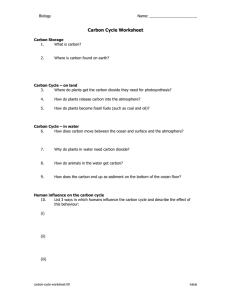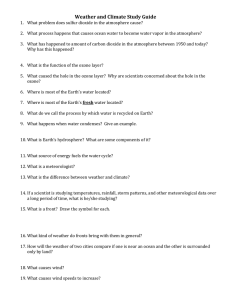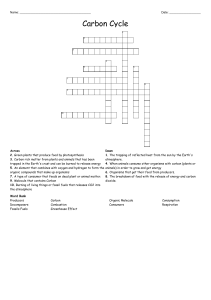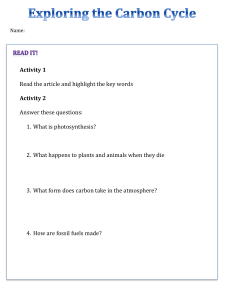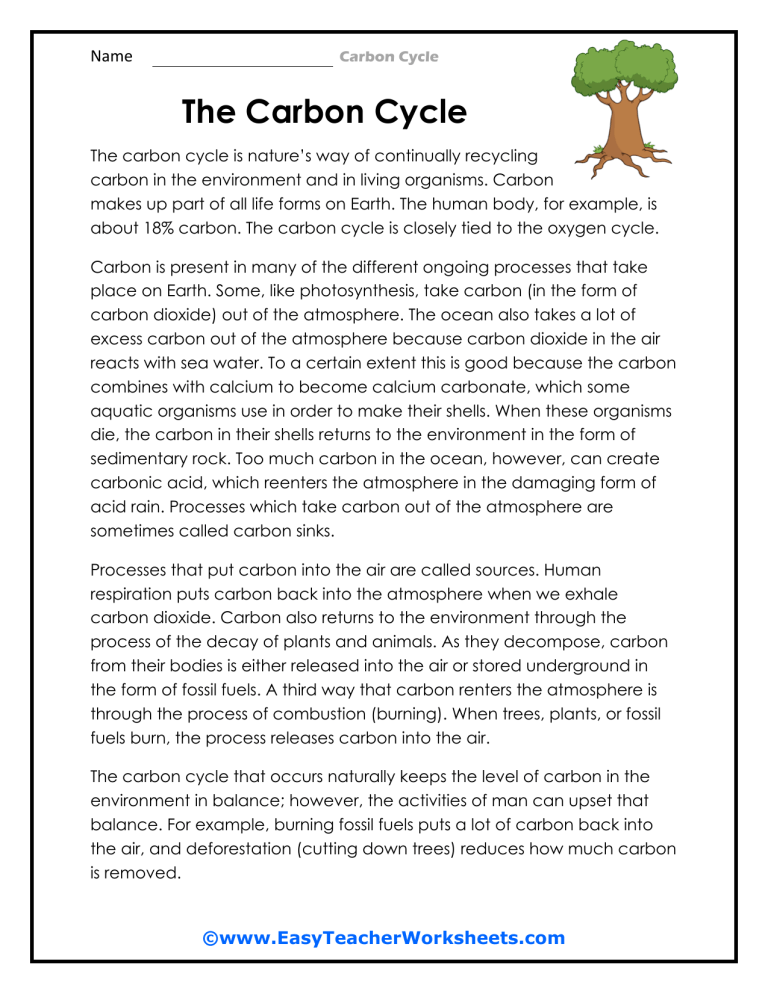
Name Carbon Cycle The Carbon Cycle The carbon cycle is nature’s way of continually recycling carbon in the environment and in living organisms. Carbon makes up part of all life forms on Earth. The human body, for example, is about 18% carbon. The carbon cycle is closely tied to the oxygen cycle. Carbon is present in many of the different ongoing processes that take place on Earth. Some, like photosynthesis, take carbon (in the form of carbon dioxide) out of the atmosphere. The ocean also takes a lot of excess carbon out of the atmosphere because carbon dioxide in the air reacts with sea water. To a certain extent this is good because the carbon combines with calcium to become calcium carbonate, which some aquatic organisms use in order to make their shells. When these organisms die, the carbon in their shells returns to the environment in the form of sedimentary rock. Too much carbon in the ocean, however, can create carbonic acid, which reenters the atmosphere in the damaging form of acid rain. Processes which take carbon out of the atmosphere are sometimes called carbon sinks. Processes that put carbon into the air are called sources. Human respiration puts carbon back into the atmosphere when we exhale carbon dioxide. Carbon also returns to the environment through the process of the decay of plants and animals. As they decompose, carbon from their bodies is either released into the air or stored underground in the form of fossil fuels. A third way that carbon renters the atmosphere is through the process of combustion (burning). When trees, plants, or fossil fuels burn, the process releases carbon into the air. The carbon cycle that occurs naturally keeps the level of carbon in the environment in balance; however, the activities of man can upset that balance. For example, burning fossil fuels puts a lot of carbon back into the air, and deforestation (cutting down trees) reduces how much carbon is removed. ©www.EasyTeacherWorksheets.com Name Carbon Cycle QUESTIONS: The Carbon Cycle Circle the correct answer. 1. Carbon is important because: A. it is part of the carbon cycle B. it makes up part of all life forms on Earth C. it is related to oxygen D. it is found in excess in the ocean 2. Which of the following processes involves carbon? A. photosynthesis B. combustion C. decay D. all of the above 3. Some aquatic organisms use calcium carbonite: A. for respiration B. to make carbonic acid C. to make their shells D. to make carbon sinks 4. Processes that put carbon into the air are called: A. carbon sinks B. sources C. photosynthesis D. combustion 5. The natural carbon cycle: A. keeps the level of carbon in the environment in balance B. can upset the activities of man C. puts a lot of carbon back into the air D. reduces how much carbon is removed. ©www.EasyTeacherWorksheets.com Carbon Cycle Name What Is Carbon? Carbon makes up part of all life forms on Earth, and nature continually recycles carbon in the environment and in living organisms in what is called the carbon cycle. Carbon is a part of more compounds than any other element. It is present in carbon dioxide in the Earth’s atmosphere. It is also present in all plant and animal life, which why we use the term “carbon-based lifeforms.” It forms a major part of rock formations like limestone and marble. It dissolves in large bodies of water, including the ocean. It is also found in fossil fuels like coal, natural gas, and petroleum. Other common forms of carbon are described below. It is the fourth most plentiful element in the universe by mass and the second most plentiful element in the human body. Carbon has some key distinguishing characteristics. It is able to make long chains of molecules by hooking together with other carbon atoms. In fact, carbon exists on Earth in three different forms called allotropes. An allotrope is a material that is composed entirely of the same element, but in each allotrope, the atoms of the element fit together differently. The three allotropes of carbon are amorphous, graphite, and diamond. Amorphous carbon is most commonly seen in the forms of soot and coal. Graphite carbon is the softest of the three. This blackish grey substance is found most commonly in pencil lead. In its diamond form, carbon is transparent, and the hardest substance known in nature. Carbon has the highest melting point of all known elements. Almost every human industry uses carbon in some way. Any industry that uses coal, methane gas, or crude oil (a precursor of gasoline) uses carbon. Carbon is used in the production of plastics, as well as in allows like steel. There is even carbon in black printer ink and black paint. ©www.EasyTeacherWorksheets.com Carbon Cycle Name QUESTIONS: What Is Carbon? 1. What is the carbon cycle? 2. How widespread is carbon in compounds compared to other elements? 3. Why do we use the term “carbon-based life forms?” 4. What is an allotrope? 5. What are the three allotropes of carbon? 6. What allotrope of carbon is found in pencil lead? 7. Name some human industries that use carbon. ©www.EasyTeacherWorksheets.com
